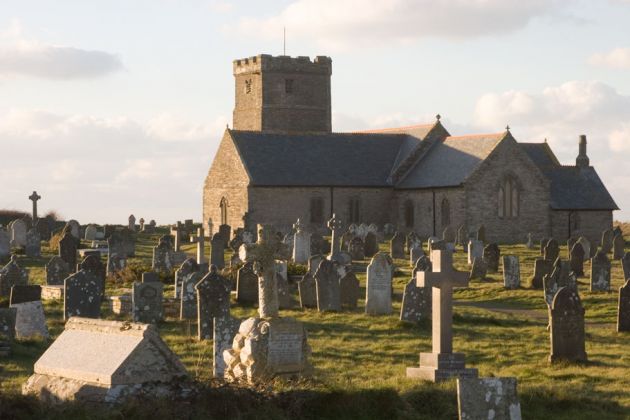The very name of Tintagel brings to mind thoughts of knights in armour, Camelot, and Excalibur. And if it doesn't, it soon will. Connected with the legend of King Arthur for hundreds of years, Tintagel is without doubt one of the most evocative destinations anywhere in Cornwall. Both wild and historic in equal measure, it has an amazing array of attractions.
Our list of the best things to do in Tintagel are all fairly concentrated around the village itself, and are all reachable by foot from here. They aren't listed in any particular order of preference, although they could possibly be in order of popularity, but this of course has no bearing on quality!
Tintagel Castle
Clinging to the windswept cliffs on an epic stretch of north Cornwall coastline, Tintagel Castle has been considered the home turf of King Arthur since at least the twelfth century. Potentially occupied as early as the Roman period, the present ruins date to the 1230s. They sit on Tintagel 'island', married to the mainland by a contemporary bridge. It replaces a medieval crossing lost for centuries, and precludes the need to tackle steep steps across wet granite. In as dramatic a location as any you'll find in the county, you'll soon fall under Tintagel Castle's spell.
Tintagel Old Post Office
An exquisite example of a traditional Cornish longhouse, Tintagel Old Post Office dates to the fourteenth century and could well be the quaintest building in all Cornwall. An astonishing survivor of the medieval period, it's thick stone walls and undulating slate roof conform to the plan of manor houses from the period. Its interior has been restored to its Victorian appearance, when it was licenced as the district's official receiving station for the penny post, offering insight into more than 600 years of Cornish history along the way.
King Arthur's Great Halls
At the heart of Tintagel, on Fore Street, King Arthur's Great Halls may only date to 1933, but it still has an important place in preserving the mythology surrounding King Arthur and his Knights of the Round Table. Constructed of 53 different types of Cornish stone, the medieval-style hall includes a round table and granite throne, as well as a series of 73 stained glass windows by Victoria Whall, an important figure in the Arts and Crafts movement. This dramatic space has also been used by four Masonic groups, which only adds to its sense of mystery and intrigue.
Merlin's Cave
Tunnelling beneath the Tintagel peninsula for close to 100 metres, Merlin's Cave claims to be the legendary residence of King Arthur's right hand man and magician-in-chief. Accessible at low tide via a short stretch of beach around an attractive cove, the cave is also said to be the place where Merlin rescued a newborn Arthur from certain death among the waves. While exploring, look out for the contemporary likeness of the mystic carved to one side of the cave entrance.
Trebarwith Strand
The rise and fall of limestone cliffs topped with a blanket of meadow flowers provides the backdrop for this stunning area of coastline lying just over two miles south of Tintagel. Incorporated into the South West Coast Path, years of wave action have carved out a series of intriguing natural caves, which meld into a sandy beach some 800 metres long when the tide draws out. Low tide also reveals a wealth of rock pools stretching most of the way to Otterham (Gull) Rock. When the swell is up and the wind offshore Trebarwith Strand is a popular spot for surfing on this otherwise rugged coast.
St Nectan's Glen
It's the sound of trickling water that greets visitors who delve into the dappled woodlands of St Nectan's Glen. Lining the shallow pebble shores of the Trethevy River, the glen leads to St Nectan's Kieve, a plunge pool constantly fed by the rushing waters of an eighteen-metre-high waterfall. Carving its way among the mossy rocks, this haven of peace is dotted with ribbons, family photographs and manmade stone stacks offered to the woodland spirits and in reverence of St Nectan himself who is said to have his hermitage here. The glen itself is also a site of special scientific interest due to its unique flora and fauna.
Rocky Valley
Soaring up to twenty meters above the Trethevy river as it cascades down to the sea, Cornwall's Rocky Valley is a sylvian delight. The forest bluebells of St Nectan's Glen give way to extraordinary moorland landscapes. This in turn evolves into layer upon layer of natural slate, which glint in the constant river spray and give this narrowing gully its name. Scattered with the ruins of historic mills, and mystical labyrinth carvings of unknown origin, views can stretch as far as the island of Lundy on the clearest days.
Coastal Scenery
Tintagel and surrounds, are without doubt, home to some of Cornwall's most impressive and iconic coastal scenery. The cliff top views around Tintagel Head itself will not fail to impress and for those willing to take the coast path in either direction it only gets better. The walk to Boscastle is quite manageable and well worth it to see the dramatic harbour inlet between the towering cliffs. For a more challenging walk you can head westwards towards Port Isaac, taking in Trebarwith Strand and a number of other hidden coves along the route.
St Materiana Church
Set beyond the village and enduring the full force of the British climate from its theatrical location on the edge of Tintagel's cliffs, the parish church of St Materiana is believed to belong to the crossover period between Saxon England and the Norman Conquest. A place of shelter and security for centuries, Norman relics include an impressive stone baptismal font, while the south transect also guards a milestone dating to Cornwall's even more distant Roman past.














